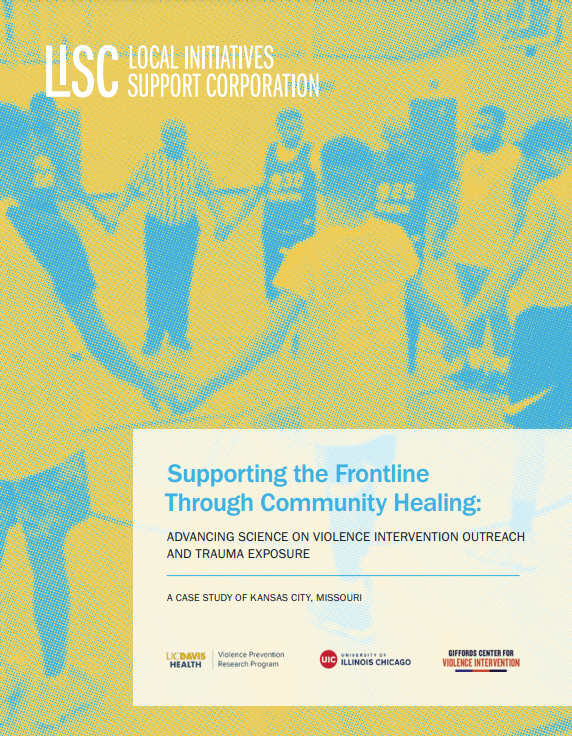Supporting the Frontline Through Community Healing
The report reflects a collaboration between the University of California, Davis, the University of Illinois Chicago, and Giffords Center for Violence Intervention. The principal investigators of the report are Dr. Kathryn Bocanegra (UIC) and Dr. Shani Buggs (UC Davis). This project was funded by LISC and Giffords Law Center. The research team is especially grateful for the contribution of experts in Kansas City, MO, who generously shared their time and experience for this project. The research team, along with these experts, connected through a shared commitment to holistic community safety.
Introduction
Over the past two years, gun violence has skyrocketed across the United States, with more gun homicides in 2020 than in any other single year since 1994—and these trends continued in 2021. Data from individual cities showed that these increases were nearly universal for both homicides and nonfatal shootings. In 2020, only five of the nation’s 50 largest cities saw decreases in homicides compared to 2019 and nonfatal shooting were up by roughly 60% in those cities for that same time period.1
Community Violence Intervention (CVI) is an extremely promising, nationally recognized strategy to reduce gun violence. CVI relies on concerned individuals, native to the community, who are willing to accept the role of peacemaker and work tirelessly to reduce violence by engaging those at highest risk of being injured and/or producing violence.2 A 2017 study done by the University of California, Los Angeles, and the University of Southern California found that over a two-year period, frontline violence intervention workers in South Los Angeles reduced retaliatory group violence by more than 43%. When only police responded to a gang-related homicide, there was a 24% chance of a retaliatory killing. But when both police and CVI workers responded separately, the likelihood of a retaliatory homicide was less than 1%.3 An 18% reduction in gun violence citywide and up to 29% reduction in certain neighborhoods from 2018 to 2019 was attributed to a CVI effort in Sacramento, CA, using street outreach workers as violence interrupters and mentors.4 Evaluation of a hospital-based CVI program in Oakland, CA, found that young people who received support from trained intervention specialists while recovering from violent injury were 70% less likely to be arrested and 60% less likely to have any criminal involvement, compared to those that did not go through the program.2
Community Violence Intervention has generated increased attention in recent years and only more so after President Biden publicly announced it as part of his comprehensive plan to respond to firearm crime across the country.5 This plan permits local jurisdictions to devote a portion of the $350 billion in federal American Rescue Plan Act funding to support CVI programming and CVI capacity building. While not all of these funds have been allocated or spent, at least $10 billion of this funding has already been dedicated by dozens of states, counties, and cities to public safety and violence prevention, which includes supporting existing programs and expanding CVI efforts. In many cities, the investment of public funds into CVI efforts was preceded by expanding private investments in CVI efforts, such as the Partnership for Safe and Peaceful Communities (a funding coalition in Chicago).
With the increased attention and support of CVI strategies in violence reduction efforts comes increased scrutiny of their evidence base and capacity to expand programming and deepen impact. Numerous efforts are underway with existing CVI leaders and myriad community violence intervention stakeholders to gain wisdom and learn from their successes, challenges, and suggestions for how to improve and build the CVI field and the community safety infrastructure in which CVI can optimally operate. Local Initiatives Support Corporation (LISC) is one such leader in these efforts, working with the U.S. Department of Justice’s Bureau of Justice Assistance to gather insight from CVI experts, technical assistance providers, and trainers to develop a CVI toolkit for implementing these programs in cities around the nation. The National LISC office has also funded a study, to be published soon, of the implementation and operational challenges of CVI programs that utilize outreach workers and violence interruption tactics to quell potentially lethal conflicts. That research has illuminated numerous successes and opportunities for CVI programs to be strengthened through increases in funding, community partnerships, and sustained political commitment.
